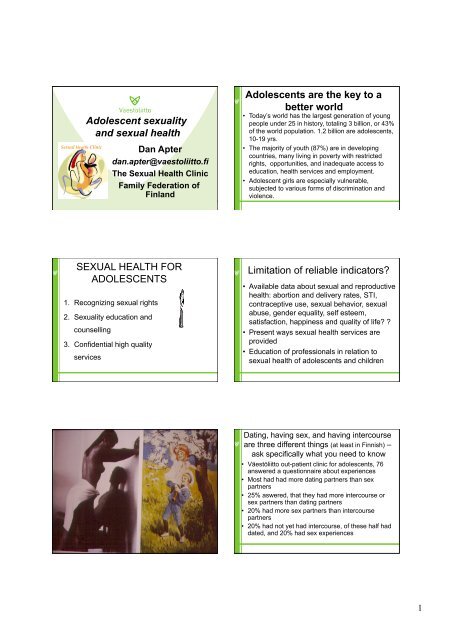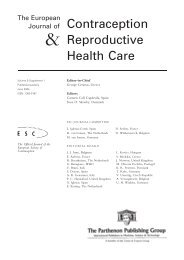Adolescent sexuality and sexual health - Dan Apter - The European ...
Adolescent sexuality and sexual health - Dan Apter - The European ...
Adolescent sexuality and sexual health - Dan Apter - The European ...
You also want an ePaper? Increase the reach of your titles
YUMPU automatically turns print PDFs into web optimized ePapers that Google loves.
Sexual Health Clinic<br />
<strong>Adolescent</strong> <strong><strong>sexual</strong>ity</strong><br />
<strong>and</strong> <strong>sexual</strong> <strong>health</strong><br />
<strong>Dan</strong> <strong>Apter</strong><br />
dan.apter@vaestoliitto.fi<br />
<strong>The</strong> Sexual Health Clinic<br />
Family Federation of<br />
Finl<strong>and</strong><br />
<strong>Adolescent</strong>s are the key to a<br />
better world<br />
• Today’s world has the largest generation of young<br />
people under 25 in history, totaling 3 billion, or 43%<br />
of the world population. 1.2 billion are adolescents,<br />
10-19 yrs.<br />
• <strong>The</strong> majority of youth (87%) are in developing<br />
countries, many living in poverty with restricted<br />
rights, opportunities, <strong>and</strong> inadequate access to<br />
education, <strong>health</strong> services <strong>and</strong> employment.<br />
• <strong>Adolescent</strong> girls are especially vulnerable,<br />
subjected to various forms of discrimination <strong>and</strong><br />
violence.<br />
SEXUAL HEALTH FOR<br />
ADOLESCENTS<br />
1. Recognizing <strong>sexual</strong> rights<br />
2. Sexuality education <strong>and</strong><br />
counselling<br />
3. Confidential high quality<br />
services<br />
Limitation of reliable indicators?<br />
• Available data about <strong>sexual</strong> <strong>and</strong> reproductive<br />
<strong>health</strong>: abortion <strong>and</strong> delivery rates, STI,<br />
contraceptive use, <strong>sexual</strong> behavior, <strong>sexual</strong><br />
abuse, gender equality, self esteem,<br />
satisfaction, happiness <strong>and</strong> quality of life? ?<br />
• Present ways <strong>sexual</strong> <strong>health</strong> services are<br />
provided<br />
• Education of professionals in relation to<br />
<strong>sexual</strong> <strong>health</strong> of adolescents <strong>and</strong> children<br />
Dating, having sex, <strong>and</strong> having intercourse<br />
are three different things (at least in Finnish) –<br />
ask specifically what you need to know<br />
• Väestöliitto out-patient clinic for adolescents, 76<br />
answered a questionnaire about experiences<br />
• Most had had more dating partners than sex<br />
partners<br />
• 25% aswered, that they had more intercourse or<br />
sex partners than dating partners<br />
• 20% had more sex partners than intercourse<br />
partners<br />
• 20% had not yet had intercourse, of these half had<br />
dated, <strong>and</strong> 20% had sex experiences<br />
1
Median age of first intercourse,<br />
Finl<strong>and</strong><br />
• Girls 16,8 yr<br />
• Boys 17,4 yr<br />
• Based on 200 000 answers of<br />
13-19 yr olds to a questionnaire<br />
in 2008-09<br />
Simopekka Vänskä, THL<br />
26-06-2013<br />
Reported experiences by girls<br />
School <strong>health</strong> study 2010, Finl<strong>and</strong><br />
%<br />
90 <br />
80 <br />
70 <br />
60 <br />
50 <br />
40 <br />
30 <br />
20 <br />
10 <br />
0 <br />
14 15 16 17 <br />
Age<br />
kissing <br />
Caressing on clothes <br />
Caressing below <br />
clothes <br />
Intercourse <br />
Sex is amazing<br />
• In Eastern <strong>and</strong> Southern Europe, mean<br />
age at first intercourse as reported by men<br />
is one year earlier than women<br />
• In the Nordic countries, mean age at first<br />
intercourse as reported by men is half to<br />
one year later than women<br />
• In all countries, women report that their<br />
first male partner was older than they were<br />
themselves.<br />
Lesbian, Gay, Bi<strong>sexual</strong>, Transgender,<br />
<strong>and</strong> Questioning (LGBTQ) Youth, US<br />
• Five percent of high school students report they are<br />
either lesbian, gay, bi<strong>sexual</strong>, or have had <strong>sexual</strong><br />
experiences with individuals of the same sex.<br />
• Most <strong><strong>sexual</strong>ity</strong> education programs do not cover this<br />
topic<br />
• LGBTQ youth commonly experience high rates of<br />
discrimination <strong>and</strong> harassment<br />
• LGBTQ youth are more vulnerable to a variety of<br />
harmful behaviors <strong>and</strong> experiences, including<br />
skipping school, attempting suicide, <strong>and</strong> <strong>sexual</strong><br />
abuse, than their hetero<strong>sexual</strong> peers.<br />
www.SIECUS.org<br />
Age at first <strong>sexual</strong> experiences,<br />
female students in Canada<br />
Malacad <strong>and</strong> Hess, Eur J Contracept Reprod Health Care,<br />
2010;15:177–185, DOI: 10.3109/13625181003797298<br />
2
Emotions at <strong>sexual</strong> experiences<br />
First sex, Kenya<br />
Girls 12-24 years in secondary<br />
school<br />
• Forced 24 %<br />
• Tricked 17.5 %<br />
• Show love 21 %<br />
• Curious 33 %<br />
• Other 4 %<br />
Volition of Early Intercourse<br />
Sexual behavior quite similar, consequences differ<br />
Percentage of women<br />
aged 20–24 years<br />
reporting first intercourse<br />
in their teenage years<br />
Birth <strong>and</strong> abortion<br />
rates per 1000 15–<br />
19 year olds<br />
Robert T. Brown, US<br />
Age at first intercourse<br />
Finl<strong>and</strong><br />
Sweden<br />
France<br />
Canada<br />
UK<br />
USA<br />
0 20 40 60 80 100<br />
By age 15 By age 18 By age 20<br />
Finl<strong>and</strong><br />
Swede<br />
n<br />
France<br />
Canada<br />
UK<br />
USA<br />
0 10 20 30 40 50 60<br />
Birth Abortion<br />
26-06-2013<br />
Age-specific fertility rates (live births per<br />
1,000 girls) for 15-19 year-olds by income<br />
quintile <strong>and</strong> region<br />
Region<br />
Regional<br />
average<br />
Poorest<br />
quintile<br />
Richest<br />
quintile<br />
Ratio of fertility<br />
rates Poor-Rich<br />
East Asia 42.4 75.6 17.6 4.3<br />
Central <strong>and</strong> Eastern<br />
Europe, Central Asia<br />
Latin America,<br />
Caribbean<br />
Middle East, North<br />
Africa<br />
52.7 70 31.3 2.3<br />
95.7 169.5 39.2 4.3<br />
57.8 68.2 35.1 1.9<br />
South Asia 107.0 142.0 57.9 2.5<br />
Sub-Saharan Africa 129.7 168.1 75.4 2.2<br />
All, average 103.0 142.5 56.6 2.5<br />
UNFPA 2012 <br />
• Pregnancy is a leading cause of death for girls<br />
aged 15 to 19 worldwide, with complications<br />
of childbirth <strong>and</strong> unsafe abortion being the<br />
major factors.<br />
• For both physiological <strong>and</strong><br />
social reasons, girls 15 to<br />
19 are twice as likely to die<br />
in childbirth as those in the<br />
twenties. Girls < age 15 are<br />
five times as likely to die as<br />
those in their twenties.<br />
• Teenagers are more likely than older women to have illegal<br />
abortions because of legal, social <strong>and</strong> financial reasons.<br />
3
Sexual <strong>and</strong> reproductive <strong>health</strong><br />
<strong>and</strong> rights?<br />
In many developing countries (including some<br />
<strong>European</strong> countries):<br />
• Young people are denied access to information<br />
(how to prevent from <strong>sexual</strong>ly transmitted diseases,<br />
HIV, pregnancies)<br />
• Young people are denied access to reproductive<br />
supplies (contraceptives) or contraceptives are not<br />
available or too expensive<br />
• Young people are denied access to services<br />
(because young people should not have sex!)<br />
• <strong>The</strong>re was poor country, suffering<br />
the consequences of war<br />
• STIs were common<br />
• Contraception hardly existing,<br />
• Women dying of illegal abortion<br />
Finl<strong>and</strong> 65 years ago<br />
Abortions <strong>and</strong> deliveries (per 1000) in<br />
15-19 yr old girls in Finl<strong>and</strong> 1975 - 2011<br />
Sex.edu <strong>and</strong><br />
<strong>health</strong> services<br />
developed<br />
Sex.edu <strong>and</strong><br />
<strong>health</strong> services<br />
were reduced<br />
Sexuality education<br />
developed again<br />
Conclusions<br />
7,8<br />
Sexual Health Clinic<br />
Cultural strategies for<br />
adolescent <strong><strong>sexual</strong>ity</strong><br />
• early marriage<br />
• segregation of sexes<br />
• repression<br />
• acceptance<br />
4
MARRIAGE AND SEXUAL<br />
RELATIONSHIPS<br />
• <strong>The</strong> poorer the country <strong>and</strong> region, the greater the<br />
chances are that adolescent women are married.<br />
• 29 % of adolescent women in Sub-Saharan Africa<br />
are married, as are 22% in South Central <strong>and</strong><br />
Southeast Asia <strong>and</strong> 15% in Latin America <strong>and</strong> the<br />
Caribbean.<br />
• An estimated 39% of women aged 15–19 living in<br />
low-income countries in these regions are married,<br />
as are 27% of those living in lower-middle–income<br />
countries <strong>and</strong> 13% of those in upper-middle– to<br />
high-income countries.<br />
Countries with the highest rate of<br />
child marriage<br />
Country<br />
Niger 75 %<br />
Chad 72 %<br />
Bangladesh 66 %<br />
Guinea 63 %<br />
Central African Republic 61 %<br />
Mali 55 %<br />
Mozambique 52 %<br />
Malawi 50 %<br />
Per cent girls<br />
married before<br />
age 18<br />
UNFPA 2012<br />
Sexual <strong>health</strong> services<br />
• Services for adolescents can be provided in<br />
various settings.<br />
• <strong>The</strong> clinic should have a youth-friendly<br />
atmosphere, where young people can feel<br />
welcome <strong>and</strong> comfortable.<br />
• Unquestionable confidentiality is important.<br />
<strong>The</strong> providers must not moralize <strong>and</strong> judge<br />
the adolescents, but treat adolescents with<br />
respect indicating that young people are<br />
important.<br />
WHO Regional Office for Europe <strong>and</strong> BZgA<br />
A framework for policy makers,<br />
educational <strong>and</strong> <strong>health</strong> authorities<br />
<strong>and</strong> specialists<br />
Use of contraception at last intercourse,<br />
<strong>and</strong> % girls who have had intercourse,<br />
Finl<strong>and</strong><br />
STAKES, 2010 <br />
primary <br />
Sec high school Voca9onal school <br />
8. Grade 9. Grade 1. Grade 2. Grade 1. Grade 2. Grade <br />
Nothing 19 15 8 7 12 12 <br />
Condom 62 53 49 41 36 31 <br />
OC 12 22 33 41 41 47 <br />
Condom <strong>and</strong> <br />
OC 6 7 9 10 8 8 <br />
Have had ic, <br />
% of all 14 28 36 52 66 79 <br />
SEX, PREGNANCY AND<br />
ABORTION<br />
• <strong>The</strong> US pregnancy rate per 1,000 women aged 15–19<br />
was 68 in 2008.<br />
• <strong>The</strong> rate declined between 1995 <strong>and</strong> 2002 as the<br />
result of improvements in contraceptive use.<br />
• Of the approximately 750,000 teen pregnancies that<br />
occur each year, 82% are unintended. 59% end in birth<br />
<strong>and</strong> more than one-quarter end in abortion.<br />
• In 2009, there were 39.1 births per 1000 women aged<br />
15–19.<br />
• <strong>The</strong> 2008 teenage abortion rate was 17.8 abortions<br />
per 1,000 women.<br />
Guttmacher Institute 2010<br />
5
WHERE ADOLESCENT<br />
WOMEN LIVE<br />
• <strong>The</strong>re are an estimated 260 million women <strong>and</strong> 280<br />
million men aged 15–19 in developing countries.<br />
• An estimated 70% of these adolescent women live<br />
in Sub-Saharan Africa (45 million), South Central<br />
<strong>and</strong> Southeast Asia (113 million), <strong>and</strong> Latin America<br />
<strong>and</strong> the Caribbean (45 million).<br />
• Variations in patterns of marriage, contraceptive<br />
use <strong>and</strong> levels of unintended pregnancy among<br />
adolescent women are closely linked to their<br />
region <strong>and</strong> the level of poverty in their country<br />
CONTRACEPTIVE ISSUES FOR<br />
ADOLESCENTS<br />
No medical reason currently exists to deny<br />
any method based on young age alone.<br />
No long term endocrine effects<br />
Non-medical issues:<br />
• High risk behaviour, STI<br />
• Lack of accurate information<br />
• Compliance – lack of consistent <strong>and</strong><br />
correct use of methods<br />
Emergency contraception<br />
• Good back-up for condom users<br />
• Available without prescription in many<br />
<strong>European</strong> countries, good experience<br />
• Levonorgestrel can be taken as a single<br />
dose of 1.5 mg WHO, Lancet Dec 2002, 360:1803<br />
• No relevant contraindications<br />
• Both potential problems <strong>and</strong><br />
contraceptive efficacy have been<br />
overestimated<br />
• A tablet can not compensate for lack of<br />
<strong><strong>sexual</strong>ity</strong> education <strong>and</strong> counselling<br />
US vs <strong>European</strong> comparison<br />
• Compared with their Canadian <strong>and</strong> <strong>European</strong><br />
peers, U.S. teens have a similar level of <strong>sexual</strong><br />
activity, but they are more likely to have shorter <strong>and</strong><br />
less consistent <strong>sexual</strong> relationships, <strong>and</strong> are less<br />
likely to use contraceptives, especially the pill or<br />
dual methods.<br />
• Every year, roughly nine million new STIs occur<br />
among teens <strong>and</strong> young adults in the United States.<br />
Compared with rates among teens in Canada <strong>and</strong><br />
Western Europe, rates of gonorrhea <strong>and</strong> chlamydia<br />
among U.S. teens are extremely high.<br />
Guttmacher Institute 2010<br />
Sexual abstinence only programmes<br />
to prevent HIV infection in high<br />
income countries: systemic review<br />
Underhill et al BMJ 2007<br />
• 13 trials enrolling 16 000 US youths identified,<br />
all outcomes were self reported<br />
• No program affected incidence of unprotected<br />
sex, number of partners, condom use, or<br />
<strong>sexual</strong> initiation<br />
Experiences of <strong>sexual</strong> abuse among<br />
girls seeking contraception<br />
• 213 first time visits in 2005, retrospecitve<br />
follow-up of journal until end 2008<br />
• 54 clients, 25%, reported some form of <strong>sexual</strong><br />
abuse when asked about it.<br />
• Mean age 15,9 (13-20) years<br />
• 76 % told about it at the first visit, 17% at 2-3<br />
visit, 4% at 4-5th visit.<br />
• Touching 33%, forced intercourse 25%, verbal<br />
21%<br />
Rinkinen et al, 2012<br />
6
Differences between Europe <strong>and</strong><br />
US<br />
• In Europe, <strong><strong>sexual</strong>ity</strong> education focuses primarily<br />
on personal growth, while in the US sex<br />
education is more seen as solving problems or<br />
preventing them. This fundamental difference is<br />
due to the many historical, social <strong>and</strong> cultural<br />
reasons.<br />
• In Western Europe, <strong><strong>sexual</strong>ity</strong>, as it arises <strong>and</strong><br />
develops in adolescence, is not seen as<br />
primarily a problem <strong>and</strong> a threat, but as an<br />
important part of life.<br />
26-06-2013<br />
Sexuality education works !<br />
• Two thirds of the programs significantly improved<br />
one or more aspects of <strong>sexual</strong> behavior.<br />
• <strong>The</strong> evidence is strong that programs do not hasten<br />
or increase <strong>sexual</strong> behavior but, instead, some<br />
programs delay or decrease <strong>sexual</strong> behaviors or<br />
increase condom or contraceptive use.<br />
• Of the 54 studies measuring program impact on<br />
condom use, almost half (48%) showed increased<br />
condom use; none found decreased condom use.<br />
• Programs were effective across a wide variety of<br />
countries, cultures, <strong>and</strong> groups of youth.<br />
Douglas Kirby 2007, 2011<br />
Low income countries<br />
• Most women aged 15–19 in Sub-Saharan Africa<br />
—some 83%—live in low-income countries, while<br />
71% of those in South Central <strong>and</strong> Southeast<br />
Asia live in lowermiddle– income countries.<br />
• Variations in patterns of marriage, contraceptive<br />
use <strong>and</strong> levels of unintended pregnancy among<br />
adolescent women are closely linked to their<br />
region <strong>and</strong> the level of poverty in their country.<br />
% girls who have had intercourse,<br />
Finl<strong>and</strong> 1996-2007<br />
STAKES school <strong>health</strong> survey<br />
%-girls who did not use contraception at<br />
last intercourse<br />
Number of sex partners by age, girls<br />
School <strong>health</strong> survey 2008-09<br />
Age<br />
Simopekka Vänskä, THL<br />
7








